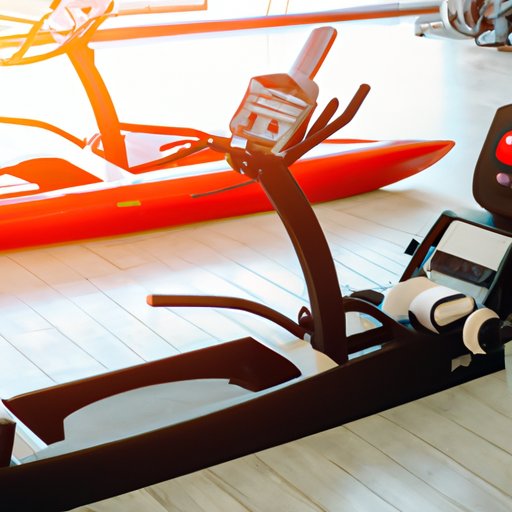
Introduction
Have you ever considered using a rowing machine as part of your fitness routine? A rowing machine is a piece of equipment that simulates the motion of rowing a boat. Not only can it provide a full-body workout, but it also has low impact and offers a variety of workout options. In this article, we will explore the benefits of using a rowing machine, how it compares to other types of cardiovascular exercise equipment, tips for beginners on how to effectively use a rowing machine for maximum results, the different types of rowing machines available, and the importance of proper form when using a rowing machine to prevent injury and optimize your workout.
The Benefits of Using a Rowing Machine for a Full-Body Workout
Rowing machines engage multiple muscle groups, making it an excellent full-body workout. The major muscles used during rowing include the legs, back, arms, and core. By using a rowing machine regularly, you can improve your endurance, cardiovascular health, and overall fitness level.
According to a study by The American Council on Exercise (ACE), rowing on a machine can burn up to 311 calories in just 30 minutes for someone who weighs 125 lbs. The same person can burn up to 377 calories in the same amount of time at 155 lbs. This indicates that rowing machines can be an efficient way to burn calories.
How Rowing Machines Compare to Other Types of Cardiovascular Exercise Equipment
Compared to other types of cardiovascular exercise equipment like treadmills, ellipticals, and stationary bikes, rowing machines offer unique benefits. One of the primary advantages of using a rowing machine is that it provides a low-impact workout. This means that it is gentler on joints than high-impact exercises like running.
Additionally, rowing machines engage multiple muscle groups in the upper and lower body, making it a great option for full-body workouts. Using a rowing machine can help you build strength and improve your balance, flexibility, and coordination.
Tips for Beginners on How to Effectively Use a Rowing Machine for Maximum Results
If you are new to rowing machines, it can be helpful to learn the proper form and technique to get the most out of your workout. First, ensure that your feet are securely strapped in and your back is straight. Next, grasp the handle with your hands, keeping them slightly wider than shoulder-width apart.
When rowing, use your legs to push off from the footrests, followed by your core and back, and finally your arms. This creates a fluid motion that mimics the motion of rowing a boat.
To get the most out of your workout, start with a low resistance level. Focus on maintaining proper form and gradually pick up the pace. You can also increase your workout intensity by increasing the resistance level and duration over time.
The Different Types of Rowing Machines Available and Which One May Be the Best Fit for Your Fitness Goals
There are four main types of rowing machines: water, air, magnetic, and hydraulic. Each type has its pros and cons, so it is important to consider your fitness goals, budget, and workout preferences when selecting a rowing machine.
Water rowing machines simulate the experience of rowing on water and provide a more natural feel. They are also aesthetically pleasing and can be used as a piece of furniture. However, they are expensive and can be noisy.
Air rowing machines use a flywheel to create resistance and simulate the feeling of rowing. They are often less expensive than water rowing machines and offer a great cardiovascular workout. However, they can be noisy and take up more space.
Magnetic rowing machines use a magnetic brake to create resistance. They are quiet, smooth, and provide a customizable workout. However, they may not provide as realistic of a rowing experience as water or air machines.
Hydraulic rowing machines use hydraulic pistons to create resistance. They are often compact and inexpensive, but may not provide enough resistance for more advanced users.
The Importance of Proper Form When Using a Rowing Machine to Prevent Injury and Optimize Your Workout
Using proper form when rowing is crucial to preventing injury and getting the most out of your workout. One common mistake is exerting too much pressure on the lower back, which can result in lower back pain. Make sure to engage your core muscles while rowing to avoid this.
Another common mistake that can result in knee problems is lifting the heel of your foot too high while pushing off from the footrests. Keep your heels firmly planted on the footrests.
Shin splints can also be a concern for some rowers. You can prevent this by wearing proper-fitting shoes with good support and cushioning.
Conclusion
In conclusion, rowing machines offer a unique and effective way to achieve a full-body workout. They engage multiple muscle groups, provide a low-impact workout, and offer a variety of workout options. By maintaining proper form and gradually increasing the intensity and duration of your workouts, you can improve your overall fitness level, build strength, and enhance your balance, flexibility, and coordination. Consider incorporating a rowing machine into your fitness routine to achieve optimal results.





